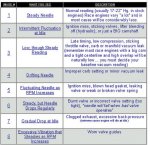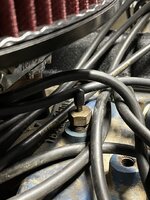The web page that Old Dog had a link to is no longer on the Internet. Here is part of that document:
INTAKE MANIFOLD PRESSURE (VACUUM) TEST
Another article copied that has good information on using a vacum gauge to get an idea of engine performance. Copied writed:
- Lesson and Web Designs: David L .Heiserman
- Publisher: SweetHaven Publishing Services
- Copyright © 2005, SweetHaven Publishing Services
Knowing the compression of engine cylinders is very useful in determining engine condition, but this is not the only test you can make for this purpose. You can also measure the amount of suction or vacuum that the cylinders have on the intake stroke. On compression-ignition engines, this is not your job, so we will look only at the spark-ignition engine.
Actually, a vacuum measurement is still a measurement of pressure, but the pressure is less than the normal air pressure that is all around us. Instead of being measured in pounds of pressure per square inch, as compression is, the vacuum is measured in inches of mercury.
The term "inches of mercury" refers to the distance that mercury in a U-shaped tube moves when a vacuum is applied to one end of a tube. For example, if the mercury rises 10 inches, the value of the vacuum is 10 inches of mercury.
Vacuum Gage
The vacuum gage that you will be using has a scale and a needle pointer like the compression gage. Each mark on the scale stands for 1 inch of mercury. Most gages will also read a small amount of pressure for checking fuel pump pressure. (This test is covered in another lesson.) The vacuum gage is issued to your unit as a kit and comes with adapters and hoses so it can be attached to any engine.
Connecting the Gage
The vacuum reading is obtained by connecting the vacuum gage to the intake manifold and then operating the engine. Recall that the intake manifold is a common pipe that connects to all of the cylinders. Almost all engines contain some sort of a plug or connection in the intake manifold. Remove the plug or fitting and replace it with a suitable adapter from the vacuum gage kit and connect the vacuum gage.
Vacuum Readings
Start the engine. When it has run long enough to reach operating temperature, look at the vacuum reading. Normal vacuum readings will vary between different engine models, so be sure to check the proper technical manual for the exact normal readings. Specifications given in the technical manual are for sea-level operations. At higher elevations, the gage readings are lowered about 1 inch of mercury for every 1,000 feet of increase in altitude. For example, Denver, Colorado, is about 5,000 feet above sea level. So the vacuum reading obtained on a vehicle at Denver will be about 5 inches less than a reading obtained on the same vehicle at sea level.
The normal reading for most engines is about 20 inches of mercury with the engine at idle speed. A steady reading in this range indicates that the engine is running as it should at this speed.
As a further check for normal engine operation, open and close the throttle quickly. If the engine is running as it should, the reading will drop to about 2 inches at wide open throttle. Then it will quickly go to about 25 inches when you close the throttle and the engine is slowing down. (The black needle on the gauge (in the illustration) indicates the normal reading and the white needle indicates the needle travel.)
Now for some of the readings you will get if the engine is NOT running properly. Sometimes the same readings that are caused by engine faults can also be caused by troubles in the engine ignition or fuel system. Therefore, we will mention all the troubles here, but we will only go into detail on faults in the engine.
If the reading is a little low and the needle floats slowly back and forth from about 12 to 16 inches, the fuel-air mixture is not correct. This is usually caused by an improperly adjusted carburetor which is covered in later lessons.
A plugged or partly plugged exhaust system will result in a normal reading when the engine is first started. But, the reading will drop off as the engine runs. How quickly the reading drops will depend on how badly the exhaust system is plugged.
A steady but below normal reading indicates a fault that affects all of the cylinders. Just how low the reading is will depend on how bad the fault is. Some of the possible faults are incorrect ignition or valve timing, a leak in the intake manifold or carburetor mounting gaskets, and uniform piston ring leakage.
If all the piston rings are leaking enough to lower the reading, the compression will also be low and blue smoke will be coming out of the exhaust. The blue smoke is caused by oil leaking from the crankcase past the rings and into the combustion chamber.
If the valve timing is incorrect, the low vacuum reading would also be accompanied by low-compression readings. If an engine uses timing gears, the valves will not get out of time once the engine has been put together properly. However, if it uses a chain and sprockets to drive the camshaft, it is possible for a worn chain to slip over one or two teeth on a sprocket. This will upset the relative position of the crankshaft and camshaft and change the valve timing.
Suppose that the gage needle repeatedly drops back about 3 to 6 inches and then returns to normal. The needle movement is regular and seems to be timed with the engine speed. This reading indicates a condition that is affecting one or more, but not all, cylinders. Problems that can cause this are an ignition miss and a leaky valve or head gasket. If the needle just drops back once in a while, the trouble is probably a sticky valve or an ignition problem.
You can locate the cylinder or cylinders that are affected by disconnecting and connecting the spark plug leads one at a time while watching the gage. When you disconnect a lead and the action of the needle is not affected, you know that this is the affected cylinder.
If you suspect leaky valves or a head gasket, perform a compression check. These procedures are explained in spark-ignition compression testing.
If the gage bounces back and forth very fast, the valve stems are probably loose in the valve guides.






